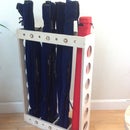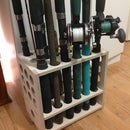Introduction: Laser Cut Box With Veneer Endless Knot Inlay
Here is a box with an inlay made entirely on a laser cutter.
I used open source Inkscape to generate the inlay design and tabbed box files for the laser cutter.
The box itself was made from 1/4 walnut plywood, and the inlay was paper-backed maple veneer.
The endless knot is a traditional design used across several cultures.
Step 1: Materials
1/4" plywood - enough for all six faces of your box
paper backed veneer - enough for your design
two jewelry box hinges
wood glue
varnish- I used water based polyurethane.
A note on plywood: The 60 watt laser I used had some difficulty cutting through the plywood I used because of knots in the core. I went with a rustic look to deal with the charring. Knot free or MDF core plywood would have provided more options.
paper backed veneer - enough for your design
two jewelry box hinges
wood glue
varnish- I used water based polyurethane.
A note on plywood: The 60 watt laser I used had some difficulty cutting through the plywood I used because of knots in the core. I went with a rustic look to deal with the charring. Knot free or MDF core plywood would have provided more options.
Step 2: Inlay Design
I used Inkscape to draw the endless knot.
The knot is composed of three shapes ( "I" "J" "P") laid out in a grid, so that the distance between the shapes assists in the illusion of a knot .
The design will have to be broken into two drawings, one for the pocket and one for the inlay. The pocket will be filled in with a color and will be raster cut into the plywood to the thickness of the veneer. The inlay will be vector cut from the veneer, so it will have to be slightly larger than the pocket cut to account for the kerf from the laser (around .002-.003" for my laser). With Inkscape, this is done by making the line for the shape the same thickness as the kerf, and then splitting the object into two. Here is a great instructable on how to do this:
https://www.instructables.com/id/Laser-cut-Marquetry/
Note the steps to find the kerf size for your laser.
For the inlay file, re-align all the pieces so that the straight sections are all parallel. this will allow you to save material on the veneer and allow the grain of the pieces to follow the flow of the knot.
The knot is composed of three shapes ( "I" "J" "P") laid out in a grid, so that the distance between the shapes assists in the illusion of a knot .
The design will have to be broken into two drawings, one for the pocket and one for the inlay. The pocket will be filled in with a color and will be raster cut into the plywood to the thickness of the veneer. The inlay will be vector cut from the veneer, so it will have to be slightly larger than the pocket cut to account for the kerf from the laser (around .002-.003" for my laser). With Inkscape, this is done by making the line for the shape the same thickness as the kerf, and then splitting the object into two. Here is a great instructable on how to do this:
https://www.instructables.com/id/Laser-cut-Marquetry/
Note the steps to find the kerf size for your laser.
For the inlay file, re-align all the pieces so that the straight sections are all parallel. this will allow you to save material on the veneer and allow the grain of the pieces to follow the flow of the knot.
Step 3: Box Design
Use the boxmaker plugin to draw the box parts: http://www.keppel.demon.co.uk/111000/111000.html. If you don't use Inkscape, there are other boxmaker tools on the web.
The boxmaker creates a drawing for a cube assembly Since I wanted a box that opens, I simply split the four side pieces into eight pieces. Make the line spitting the sides to correspond to the desired depth of the box.
The boxmaker creates a drawing for a cube assembly Since I wanted a box that opens, I simply split the four side pieces into eight pieces. Make the line spitting the sides to correspond to the desired depth of the box.
Step 4: Prep Materials for Laser
I like to put a single, light coat of laser friendly varnish on the exterior face of the plywood and veneer to minimize soot and charring issues. If I am feeling extra picky, I will also use a layer of light tack painters tape. Tape alone will work, but it can pull up bits of grain off the wood when you remove it.
Step 5: Cut
Before laser cutting the parts, it is a good idea to re-run the kerf test, especially if your laser is as moody as the one I use.
1. Cut the vectors for the box parts
2. Reposition the lid and raster the inlay pockets. Take several passes, checking the depth against your veneer width.
3. Vector cut the inlays. Try to get the veener to lay as flat as possible. This is the tricky part for veneer cuts on a laser.
1. Cut the vectors for the box parts
2. Reposition the lid and raster the inlay pockets. Take several passes, checking the depth against your veneer width.
3. Vector cut the inlays. Try to get the veener to lay as flat as possible. This is the tricky part for veneer cuts on a laser.
Step 6: Assemble and Finish
1, Glue and clamp the inlay.
2, Sand the inlay to be flush with the box surface.
3. Glue and camp the box parts.
4. Sand and finish.
4. Add the hinges.
Done!
2, Sand the inlay to be flush with the box surface.
3. Glue and camp the box parts.
4. Sand and finish.
4. Add the hinges.
Done!






